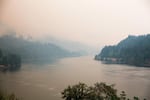
Smoke from the Eagle Creek and Indian Creek wildfires clouds the Columbia River Gorge Monday, Sept. 4, 2017.
Conrad Wilson / OPB
Burn scars left after major wildfires can look pretty bleak. But take a couple million steps back and you’ll find those fires aren’t keeping up with the natural filling-in of forest vegetation.
New research out of Oregon State University makes the case that considering the big picture is important to our understanding of fire in our region.
“You know as we zoom out, forests are growing and things are being replaced and it’s really a dynamic system,” said ecologist Matt Reilly, who’s currently at Humboldt State University in Northern California. “To really get at the ecological effects of fire, you need to look beyond the fire perimeter and see what’s going on on those unburned landscapes.”
As a researcher at OSU, Reilly, looked at forests on the east side of the Cascades from Washington to California. Only about ten percent of those forests burned between 1985 and 2010.
He found that despite the wildfires, Northwest forests are still growing faster than they burn. Overall, this area's forests are aging, rather than maintaining the mix of forest ages and types that define a healthy ecosystem. And Reilly says efforts to restore the rest of those forests to a more natural state through controlled burns and tree thinning just hasn’t been able to keep up with growth.
Melissa Lucash researches wildfire and climate change at Portland State University. She was not involved with the Oregon State study.
“We talk a lot about how we want to have different stages of succession – you know open and closed – to benefit multiple species," she says. "But we’re doing so little management on this area that we’re not able to sustain that. We’re just sort of slowly closing the canopy."
Dense forests are very susceptible to high-severity fire, which can destroy wildlife habitat and drastically change the landscape. But Reilly says perhaps an even greater threat to the forest ecosystems is the relative lack of low-intensity fire.
Low-intensity wildfires help keep megafires at bay. They're also necessary to maintain open forests and meadows and to make ecosystems east of the Cascades less vulnerable to drought and insect damage.
